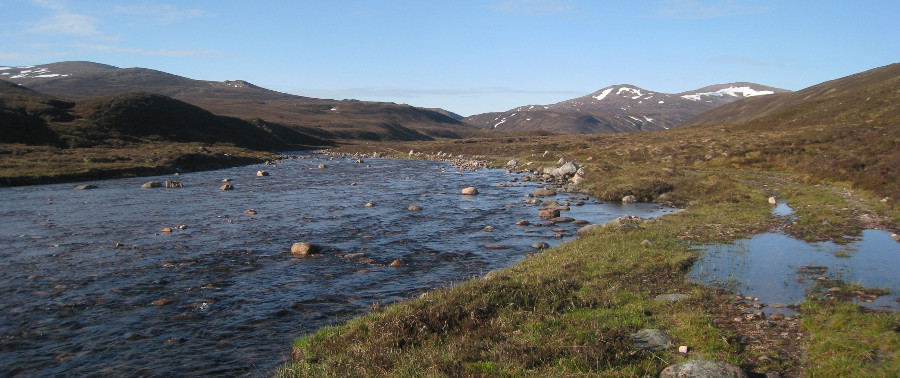In general, when in the mountains of Scotland above human habitation, the water is safe to drink, but you do have to think about where it is coming from and follow basic common sense rules.

Clear flowing water above habitation is generally safe to drink, such as here in the River Avon in the Cairngorms.
If you suspect the water where you are going will not be safe to drink, or if you just want some extra reassurance, there are several methods of purifying water. The four basic tactics are boiling, filtering, chemical treatment and ultra violet treatment.
Which you choose will depend on a number of factors, including portability, so some research is advised before opting for a particular solution.
Boiling
Boiling water is a simple and reliable method of killing off bacteria etc, but it will not clean sediment or chemical pollution from the water. You should bring water to a rolling boil for 1 min, as per the WHO recommendation.
Filtering
There is a wide range of filtering equipment available, with performance and longevity determined by a number of factors. Best to check out available options before making a choice to suit your needs.
Chemical treatment
Water purification tablets or liquids are another option. However you should check the instructions for use, as some may only be practicable for treating larger quantities of water than you can store if you are on the move or wild camping.
UV treatment
You can also obtain battery-powered ultra violet ‘pens’ which can sterilise a litre of water in just 90 seconds. Because they rely on light, they are less effective if the water is murky.
Although water from streams and rivers is generally safe, you should always follow good hygiene rules and be aware of possible water-borne infections.
Possible infections are described below:
E Coli is most likely to be contracted by swallowing water contaminated with sewerage.
Symptoms: rapid onset of diarrhoea without blood
Treatment: fast for 24 hours, drink clear fluids, water, tea without milk or commercial rehydration solutions
Shingella and Salmonella.
Symptoms: generally start 24 hours after exposure and may include fever, vomiting and diarrhoea with blood.
Treatment: visit your GP. Do not take anti-diarrheatics (for example, Imodium or Kaolin) because these may mask the symptoms.
Leptospirosis has two forms: Weils Disease (a dangerous condition which results from infection carried in rats’ urine) and the Hardjo form transmitted to humans from cattle.
Symptoms: fever and flu-like condition
Treatment: full recovery is probable if a course of penicillin is taken in time but this depends upon immediate treatment. The time factor is crucial. Go straight to your GP, explaining the symptoms and possible source of infection from infected water.
NB: a small number of cases of Leptospirosis infection have occurred on occasion around the central highlands of Scotland.
Giardia and Amoebic Dysentery.
Symptoms: these start 24 hours after exposure and may include vomiting, diarrhoea with mucous and blood, eggy sulphurous burps and foul smelling gas.
Treatment: visit your GP. A stool test is recommended to get the diagnosis and treatment correct. However, the test may be negative in the case of Giardiasis.
NB: in Scotland it is extremely rare to contract Giardia or Amoebic infection from mountain streams or lochans, and fresh-water such as this can usually be drunk untreated well away from any human habitation.
There are other possible types of hazard in water such as blue-green algae and pollution by chemicals.
If the water looks suspect - for example, stagnant, discoloured, covered in a film of growth or has an oily surface, or looks otherwise polluted - take the following advice:
Note: many small streams through areas of boggy ground or peat have an oily covering when slow running. This is not human pollution but natural chemical leaching from the peat. It is still best to avoid drinking it if possible.